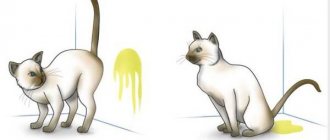Sterilization of Sphynx cats is a simple surgical operation during which the gonads and ovaries are removed. It is performed under general anesthesia, therefore, during the operation, the cat sleeps deeply and does not experience any pain.
Don and Canadian Sphynx cats, as well as cats of other breeds, periodically show signs of the onset of sexual heat or the so-called “spree”.
It manifests itself like this: a calm cat suddenly becomes not quite like itself, screams loudly, rolls on the floor, raises its tail and falls on its front paws. Some cats can leave bad-smelling puddle marks in different parts of the apartment. Sterilization of the cat helps to solve these problems and return peace to the house.
Advantages and disadvantages of manipulation
Castration of a cat has many advantages, among which the most significant is the normalization of hormonal levels, which allows the animal to live longer and calmer. It is impossible not to note the disappearance of sexual desire, as a consequence, the stabilization of the psychological state. A neutered Sphynx stops marking territory and reduces the likelihood of developing urolithiasis and cancerous tumors.
If after such an operation the female begins to suffer from urinary incontinence, then her condition can be relieved by a number of medications.
If we talk about the disadvantages of castration and sterilization of cats, then we should take into account the influence of general anesthesia, which can negatively affect the health of the pet. In addition, any operation can provoke consequences, and they do not always depend on the qualifications of the veterinarian. In females, after surgery, urinary incontinence is sometimes observed, but drug therapy helps to cope with it.
This is interesting: When is the best time to castrate a cat?
Why is sterilization necessary?
Before you understand the purpose of surgery, you need to understand the concepts of castration and sterilization. Some people are convinced that the first procedure is carried out for cats, and the second is intended for cats. This opinion is not true, since both interventions can be performed on both females and males. Castration, which is called oophorectomy for cats, is the removal of the testes in cats and the ovaries in cats. During the sterilization process, the male gonads and fallopian tubes of females are tightened. Both procedures serve to eliminate sexual desire and solve problems with unplanned offspring. Veterinarians advise making the first intervention.
How to prepare an animal?
The operation can be performed on an animal only after a medical examination.
Before the operation, the veterinarian conducts an examination. First of all, the heart is listened to and the frequency of its rhythm is determined. Then the doctor begins to examine the mucous membranes and measure body temperature. Immediately 12 hours before surgery, the cat is prohibited from giving food. The pet should not be given water 6 hours before surgery.
Preparing for castration of a cat.
Since castration is a surgical operation, it should be absolutely painless so as not to cause any discomfort to the cat. Veterinarians use special anesthetic drugs for this purpose. The use of these drugs requires compliance with certain preparation rules, by observing which you can be sure that the cat will tolerate the operation well and easily.
In order to prepare a Sphynx cat for castration, you need to undergo a “starvation diet”. He must not eat for twelve hours and not drink water for two hours before the operation. This is standard preparation before anesthesia, but we still advise you to clarify this point with the veterinarian who will perform the operation on your cat.
How does castration work?
Castration of a Sphynx cat at any age takes place under general anesthesia. Therefore, immediately before administering anesthesia, the doctor weighs the cat to accurately calculate the dose of the drug.
Important! A qualified veterinary specialist must carry out an additional preoperative examination of the Sphynx cat, regardless of the age of the animal. The doctor measures body temperature, performs auscultation of the heart and lungs, and also counts the number of heartbeats and assesses the condition of visible mucous membranes.
Algorithm for castration of Sphynx cats of all ages:
- introduction of general anesthesia;
- removal of hair on the scrotum;
- treatment of the surgical field with an antiseptic;
- cutting the skin of the scrotum with a scalpel;
- removal of both testicles;
- ligation and cutting of the spermatic cords;
- treating the incision with an antiseptic drug.
Note! There are no sutures placed on the incisions, since there are no large vessels on the skin of the scrotum in cats, and there is no risk of bleeding.
The entire castration procedure takes no more than 10-15 minutes. But the Sphynx cat can sleep for another hour after anesthesia. In good clinics, pets that have not regained consciousness are not handed over to their owners. This is done so that in the event of complications from anesthesia, the animal can be provided with professional assistance in a timely manner.
To carry out the operation, you can call a doctor at home, after consulting with him about at what age it is best to castrate a Sphynx cat. This has the following advantages:
- lack of stress from transportation and communication with other animals in the clinic;
- no risk of cat infection from contact with sick pets;
- saving owners time.
Among the disadvantages of castration at home, it is worth noting only the impossibility of providing resuscitation care to a Sphynx cat if the pet is allergic to the drug used for anesthesia. But similar facts in veterinary practice have been recorded in isolated cases.
Post-procedure care
While the animal is recovering, it should be covered with something warm.
It doesn't take much time to castrate a Sphynx. The surgical intervention lasts no longer than 20 minutes, most of which takes the administration of anesthesia. After surgery, it is permissible to leave your pet at a clinic that provides such a service or take it home. Animals generally recover from anesthesia throughout the day. Once at home, the cat should be placed on a bed, which will be covered with a waterproof diaper and a warm blanket on top. Such manipulations are required because after surgery the pet is unable to control urination because the muscle tissue is relaxed. Warmth is necessary, since after anesthesia, body temperature often decreases. It is important not to place the Sphynx on a hill, as after anesthesia, coordination of movements is impaired, and the pet may fall and be injured.
Veterinarians from the Zoovet clinic recommend massaging your cat's eyes with light movements as they dry out. While the animal is sleeping, it is important not to make loud noises. You should not leave your pet alone; you need to carefully monitor its drinking process. While the cat has not yet fully recovered from the anesthesia, he may faint and choke in a bowl of water. It is recommended to wear a special collar on your pet, which will prevent him from scratching or licking the stitches.
Important recommendations given by veterinarians after castration of sphinxes relate to diet. Now the animal will need to be given industrial complementary food exclusively for castrated cats. With the help of such a product it will be possible to prevent weight gain and the occurrence of urolithiasis. It is recommended to opt for premium and super-premium complementary foods. It is better to discuss the brand of food with the doctor who performed the castration of the Sphynx.
Breed standard
The Don Sphynx has the following breed description:
- the body is muscular and of medium size;
- back straight;
- croup slightly wider than shoulders;
- limbs are muscular, graceful;
- rounded paws, long toes;
- the tail is straight, the tip is rounded, the length of the tail is medium;
- wedge-shaped head;
- cheekbones are well developed;
- the eyebrows are pronounced;
- forehead is flat, with vertical folds;
- nose straight;
- the chin is strong and well developed;
- whisker pads are pronounced and well developed;
- the ears are large, set high, slightly tilted forward, the tips are rounded, the distance between the ears is approximately the same as the width of the ear at the base;
- eyes are almond-shaped or oval-shaped, small in size, located at a slight angle, any color is acceptable;
- there is no fur or a small invisible fluff is visible, there are numerous skin folds on the head and abdomen;
On a note! There may be short hair on the limbs, paws, tail and face, but this should disappear by the age of two. - All colors are accepted.
Types of cover
Don Sphynxes may differ in variations in skin types.
- Naked sphinx:
- homozygous - the cover is rubbery to the touch, somewhat sticky, there are no vibrissae.
The fur is completely absent and does not appear under any circumstances. Kittens are naked from birth, there is no hair in the amniotic fluid, the skin is not painted, pink. The color begins to appear a few hours or 2-3 days after birth. Such sphinxes are rare; On a note! If, with a large sample, an animal does not produce kittens with straight hair, then it can also be considered homozygous! - undressed - the cat feels rubbery to the touch, slightly sticky, there may or may not be whiskers.
There will be a small amount of fine hair in the amniotic fluid. Newborn kittens are “dressed” in the finest fluff, which will be clearly visible in the light. After 1-2 days, this fluff disappears, and the animal becomes completely naked; On a note! This version of the naked Sphynx can only be installed by an experienced breeder! - thin flock - the body of the animal is covered with very short thin villi - no more than 0.1 cm in length. It seems that the cat is completely naked, but upon closer examination, microcoating is revealed. Newborn kittens have a thin, sparse pile or fluff that falls out quite well. An adult animal has a completely naked appearance, the skin is velvety to the touch.
For Sphynxes, complete absence of hair is preferable.
- light velor - the body of the animal is covered with the finest hairs, the length of which is no more than 0.2 cm; on the paws this cover is somewhat larger. At birth, kittens are pubescent - the hair is sparse, short, and can be either soft or hard to the touch. There is a “bald spot” on the head, which is visible quite clearly;
The main fur of the velor is shed by 5-7 months.
- brush velor - the entire body is covered with thin, short, hard, sparse, crimped hairs, the length of which does not exceed 0.5 cm. On the sides, neck and back the cover is so scanty that the skin is visible. In adult individuals, this cover is often replaced by a thin flock;
Many brushes can wear their fur all their lives without “undressing”
Preparation and day of surgery
What should a cat look like before surgery:
- First of all, your pet must be absolutely healthy. Therefore, observe the animal for several days before surgery. The cat must eat well and have a healthy appetite.
- It is necessary to treat the cat for worms in advance. It is advisable to rid your pet of fleas, lice and worms every 2-3 months. It is necessary to deworm the animal at least 10 days before castration.
- Keeping your cat vaccinated is also necessary. Vaccination is a necessary condition that must be completed before castration, since immunity will be reduced after the operation. Vaccination should be carried out 10 days before deworming.
- Before the operation, it is advisable to conduct an examination of the body, in particular to find out the condition of the kidneys, heart and lungs. This is especially true for purebred cats. If there are no contraindications, then you can safely castrate your cat.
You need to take with you a warm blanket, napkins (in case the animal starts vomiting), a carrier, bedding for the carrier: a sheet, a diaper or a mattress. Be sure to take, if available, your animal’s veterinary passport, which indicates previous vaccinations.
Feeding a cat before castration
It is advisable not to feed the cat 12 hours before the scheduled surgery. After all, the operation is also carried out with the use of narcotic substances, so the cat may vomit. On an empty stomach, it will be easier for the animal to undergo surgery without discomfort.
READ Kanikquantel for cats: instructions for use and prevention
This is interesting: Does a neutered cat continue to want a cat?
Castration and sterilization of the Sphynx
In the last few years, a new concept has appeared on the veterinary services market: planned spaying and castration of Sphynx cats. What it is? Many animal owners ask veterinarians questions: why do they sterilize animals, at what age is it best to do this, and is it necessary to sterilize the animal at all? The last decisive word, of course, always remains with the animal owner, but the veterinarian should help him understand this issue as much as possible.
There are many opinions regarding castration and sterilization of the Sphynx . The term castration and sterilization refers to the artificial disruption of the reproductive capacity of the body.
In this article, I tried to highlight only the facts and answer the most frequently asked questions about castration and sterilization of animals in order to make it easier for you to make a decision about this procedure.
The advantages of castration and sterilization
- The lifespan of sterilized Sphynx cats is longer.
- A sterilized Sphynx is calmer; its restless behavior and desire to run away disappear. Cats become more obedient and manageable.
- in cats , and the owners lose loud screams and meows at night, strong-smelling marks that cats leave on carpets, furniture, wallpaper, as well as fights between cats.
- Your pet will not suffer from such severe and common diseases as prostatitis, pyometra, cysts and neoplasms of the ovaries, uterus and testes.
- The use of domestic chemical contraceptives (contrasex or anti-meow) for a long period disrupts the hormonal status of the sphinx, which is fraught with the development of pathologies such as: ovarian cysts, glandular hyperplasia of the uterus, uterine tumor, and there are also frequent cases of hydrometra or pyometra. These pathologies can only be treated surgically and often lead to the death of the animal or disability.
- Sphynx cats sterilized at a young age reduce the likelihood of developing hormone-dependent malignant mammary tumors. Twenty years of experience of European colleagues has reliably proven that castration of cats before the first heat reduces the risk of mammary tumors by 50 times .
- Sexual intercourse is necessary for a cat only to reproduce.
- Animals are deprived of the ability to think logically, they are not tormented by remorse and regret about their inability to reproduce.
- In adulthood, many cats need to be spayed or neutered for medical reasons, and the anesthetic risk (risk of anesthesia) increases sharply.
Disadvantages of castration and sterilization
- Castration is performed under general anesthesia, and any anesthesia is accompanied by a certain risk for the animal’s body, albeit not high in a healthy, young animal, but still a risk
- Any surgical intervention on the body can be accompanied by complications; the higher the qualifications of the surgeon, the fewer complications, as a rule, arise, but complications can occur even with a perfectly technically performed operation
- Some obese bitches may develop urinary incontinence after sterilization, which, however, can easily be relieved with medication.
- There is an opinion that castrated cats are more susceptible to urolithiasis, but I have not found confirmation of this fact in the scientific literature.
Now I’ll tell you a little about how these operations are carried out. These operations are not unique or complex, but they should be carried out under sterile conditions. The operation in males involves removing the testes. Today, a whole variety of methods have been proposed, and the best of them is the one that the surgeon knows best.
In females, this operation is more complicated and refers to abdominal operations. To carry out sterilization, access to the abdominal cavity is necessary (through a midline or lateral incision), through which it is possible to remove the ovaries or ovaries along with the uterus. In my opinion, when sterilizing females, it is better to remove the ovaries along with the uterus, since there is no need for the uterus (without ovaries), it itself produces sex hormones (in small quantities) and the development of inflammation is possible.
Below is a list of the most frequently asked questions from owners who come for a consultation before surgery.
Preparing the Sphynx for surgery
This operation is performed under general anesthesia and requires certain preparation, namely: an 8-12-hour fasting diet. It is not recommended to give water within 4-6 hours.
Restoring the Sphynx after castration
Sphynx from anesthesia within the first 24 hours; Sphynx kittens tolerate this procedure much easier and within a few hours, and sometimes even earlier, they begin to play and become interested in food. After the operation, the Canadian Sphynx must treat the stitches (if any) for 10 days and prevent spontaneous licking of the stitches. To do this, your pet must wear a special postoperative blanket or collar. No other special care is required after the sutures are removed.
Is childbirth necessary for health?
No, there is no need for cats to give birth to their health.
Is it true that castrated animals get fat?
The increase in weight of the Canadian Sphynx after castration, which is very often feared by owners, is not its direct consequence, but depends mainly on the animal’s nutrition and on its genetic predisposition to obesity. Moreover, there are many super-premium foods created specifically for maintaining a healthy weight.
Is it better to spay or give birth control pills to females?
The answer is clear - it is better to sterilize. This is due to the fact that all pharmacological drugs produced are designed to stop one or two heats, and their long-term use causes serious hormonal problems in the body and often leads to inflammatory diseases of the uterus.
Thank you for reading my article to the end. I hope the information obtained from it will help you make the right decision.
Preparing a cat for sterilization.
Sterilization of Sphynx cats is a painless operation that is performed under anesthesia. Due to the effect of the drug on the body, some cats may vomit before surgery.
This is absolutely normal, and in order not to cause harm to the body, simple preparation is required.
Before surgery, the cat does not need to be fed for twelve hours. During this time, there will be no more food left in the stomach and the intestines will be freed, making it easier for the cat to enter a state of sleep. The cat will also not be allowed to drink two hours before anesthesia.
Antiparasitic treatment is recommended before sterilizing Sphynx cats. You will need to give your cat an anti-worming tablet about two weeks before surgery.
How is sterilization carried out?
Sterilization of Sphynx cats is carried out under anesthesia. First, your veterinarian will give your cat an injection to prepare for anesthesia. After it, the cat will become slightly intoxicated, its muscles will relax, and the cat itself will calm down. This is necessary to prepare her body for anesthesia. The doctor will make sure that the cat tolerates the effects of the drug without complications and will give her a second injection, this time under anesthesia.
Sphynx cats do not have fur on their bellies, unlike cats of other breeds. Therefore, when the cat falls asleep, first their stomach will be treated with an antiseptic solution, and then the operation will begin; there will be no need to shave anything. The surgeon will make a small puncture through which he will remove and remove the ovaries and uterus, tie off the blood vessels and apply a cosmetic suture. For Sphynxes, it is better to use absorbable suture materials so that there is no need to remove stitches and put a blanket on the cat.
What to do after sterilization?
Sphynx cats recover from anesthesia in the same way as cats of other breeds. Full recovery after anesthesia will take a day. They usually sleep for the first two or three hours, then they begin to walk and stagger like drunken people. You cannot feed your cat right away; there is a risk of vomiting, so to avoid pieces of food getting into the wrong throat, it is better to refrain from eating for several hours.
Full recovery will take a week. During this time, the skin and muscles will completely grow together, the cat will again be able to actively move, run and jump.
Stabilization of hormonal levels does not occur immediately; in order for everything to “settle down,” it will take several weeks for the hormonal levels to completely normalize. After this, the cat will no longer scream, ask for the cat and will live a calm life.
Optimal age for sterilization of Sphynx cats
It is best to spay a Sphynx cat before her first heat, which means the operation should be performed between 6 and 10 months of age.
But you need to take into account that females of this breed are considered “early” in terms of maturation, and the first estrus can begin at the age of 4-5 months. However, veterinary specialists at this age do not recommend castration of Sphynx cats, since the animal’s fragile body is still growing rapidly, and general anesthesia can negatively affect the state of the nervous and immune systems.
Very important! It is forbidden to sterilize Sphynx cats during heat at any age. This can cause excessive bleeding and be fatal.
If your cat has not been spayed before her first heat, every precaution should be taken to prevent pregnancy. The operation will need to be performed a week after the onset of anestrus.
At what age should a Sphynx be neutered?
Typically, cats are neutered between the ages of six months and one year. The Canadian and Don Sphynx are usually neutered at 7-8 months.
It is best to carry out castration before the moment when the cat begins to “walk”. Too early surgery should also be avoided, this will not harm the health of the animal.
For a more accurate answer to the question about removing the testes, it would be more correct to have the sphinx examined by a veterinarian. Only he will be able to most accurately say whether the testicles have descended into the scrotum. This is a prerequisite for a successful operation. In most cases, the testicles descend by the fourth month, but there are exceptions.
We hope that our article was useful and helped answer your questions!
How is sterilization carried out?
Before the operation, the veterinary specialist must familiarize the owners with the existing types and methods of sterilization of Sphynx cats, depending on the age and physiological condition of the animal.
| Type of sterilization | Principle of the operation | Advantages | Who is it suitable for? |
| Ovariectomy | Spaying | Cessation of the synthesis of sex hormones, absence of estrus and the possibility of developing an ovarian tumor | Young nulliparous females |
| Ovariohysterectomy | Simultaneous removal of the ovaries and uterus | Absence of signs of sexual heat, inability to form tumors and inflammations of the reproductive organs and ovaries, minimizing the risk of developing breast cancer | Adult females who have given birth, cats with uterine pathologies |
| Hysterectomy | Removal of the uterus only | Inability to reproduce offspring while maintaining hormonal levels | Most often performed during pathological childbirth at any age, when fetal freezing occurs or the uterine cavity is filled with purulent exudate |
| Tubal occlusion | Tubal ligation | Impossibility of conception and birth of offspring while maintaining the production of hormones and the presence of a period of sexual heat | The method is used extremely rarely, as it is recognized as inhumane |
Important! Hysterectomy and tubal occlusion in Sphynx cats at any age are methods that do not reduce the risk of developing inflammatory reactions, cancerous tumors and ovarian cysts. Also, their inappropriateness lies in the preservation of hormonal activity and the presence of a period of sexual heat.
All castration operations are performed under general anesthesia. The Sphynx cat is securely fixed in a dorsal position. Then, using a catheter or palpation, the bladder is released.
Next, access to internal organs is provided in one of the following ways:
- midline laparotomy;
- paramedian incision;
- incision in the groin area;
- rational incisions on the lateral abdominal wall;
- laparoscopy.
The most commonly used method of castration in Sphynx cats at any age is considered to be a median laparotomy, in which an incision in the abdominal wall is made along the linea alba. It is quite safe, provides the most convenient access to the internal genital organs and is suitable for pregnant cats.
Sterilization through a paramedian (lateral) incision is a low-traumatic method, but is not used for pregnant females.
The laparoscopic method is expensive and requires special equipment. The qualifications of the specialist who performs castration are also of great importance. At the same time, the undoubted advantages of this sterilization method are:
- low tissue trauma;
- minimal risk of infection;
- no need to apply a bandage or bandage;
- short rehabilitation period even in adulthood.
The sequence of actions of a veterinarian when performing laparoscopy on a Sphynx cat:
- making a small incision above or below the navel to insert a Veress needle;
- insufflation of the abdominal cavity with carbon dioxide;
- needle removal;
- trocar installation;
- introduction of a rigid endoscope, the image from which is displayed on the monitor screen;
- excision followed by removal of the uterus and ovaries under endoscopic control;
- placing sutures on the incisions.
The cat is given to its owners after it regains consciousness after anesthesia.
Pros and cons of the operation
The main advantages of sterilization in Sphynx cats aged 6 to 10 months are:
- absence of unwanted offspring;
- eliminating the risk of inflammatory pathologies and neoplasms of the uterus and ovaries, as well as the development of mastitis;
- reducing the risk of developing malignant tumors of the mammary glands;
- absence of symptoms of sexual heat.
Owners also note that aggressive cats become calmer and more affectionate after sterilization.
If the owners correctly determined at what age the Sphynx cat should be operated on, then the neutered pet becomes less aggressive after the procedure, does not mark its territory, and does not try to run away from the house. The risk of prostatitis is minimized.
The disadvantages of sterilizing cats and Sphynx cats at any age include:
- the need for general anesthesia;
- the emergence of a predisposition to obesity against the background of increased appetite and decreased physical activity even at a young age;
- the possibility of postoperative complications in the event of illiterate actions of the surgeon during castration or the individual characteristics of the pet’s body.
Important! Despite the widespread belief that after castration Sphynx cats are predisposed to developing urolithiasis, this fact remains controversial in the scientific literature, as it is not confirmed by experimental data. However, an unbalanced feeding diet, combined with overfeeding and lack of physical activity at any age, often provokes metabolic disorders and urinary incontinence.
To avoid such complications, it is necessary to select specialized holistic or super premium food for sterilized cats and Sphynx cats. You should also reduce the size of portions and encourage physical activity in animals at any age.
Liked? Please rate the article!











